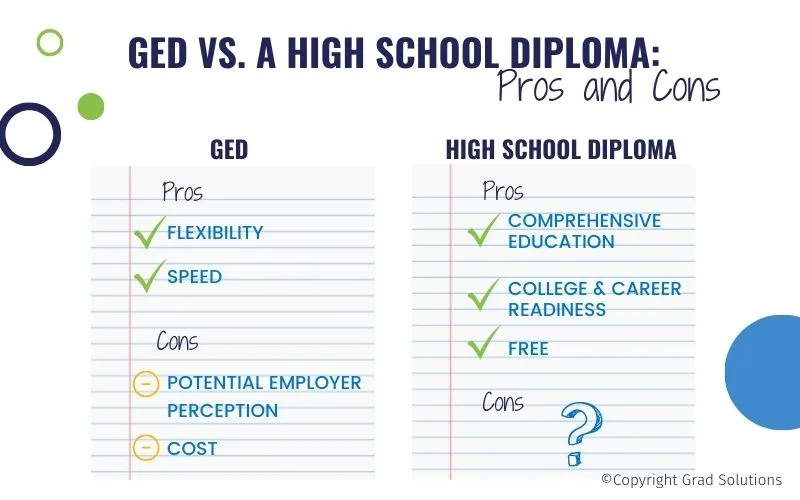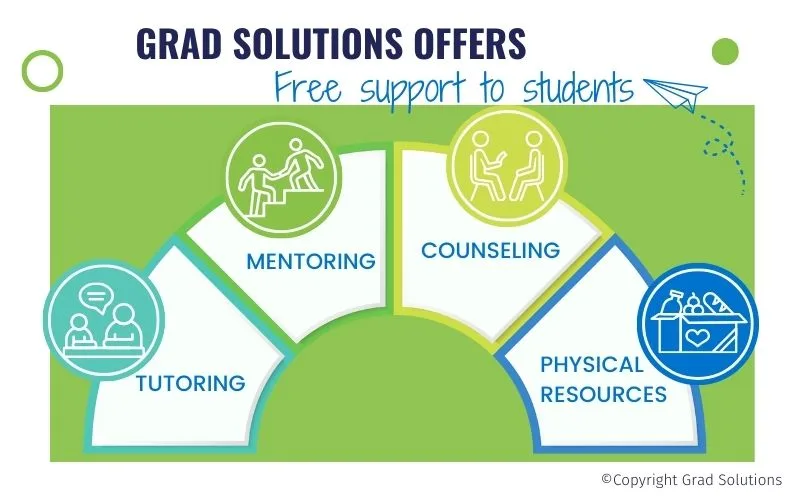Online School
GED vs Diploma: Pros and Cons

In the pursuit of higher degrees or embarking upon a chosen career path, the dilemma of choosing between the General Educational Development (GED) test and a high school diploma can be confusing. Both are valuable educational qualifications prevalent in the United States; however, each carries its own unique set of benefits and challenges.
A GED is a series of tests that, if passed, certifies the taker has high school-level academic skills. The GED exam includes four sections: Language arts, math, social studies, and science. No matter your personal circumstances, if you have dropped out of high school early or are seeking to transition your career, a GED can provide a valuable way to demonstrate your knowledge.
On the other hand, a traditional high school diploma is achieved after successful completion of prescribed coursework set forth by the school district. In the United States, the typical time frame to accumulate sufficient high school credits is four years, making the journey to a diploma a full-time commitment. As a high school dropout, there are options to obtain a high school diploma without needing to take the full four years, having to go in person, or needing to spend money.
While there are various factors to consider when deciding between these two options, the ultimate choice relies on your long-term career goals and current lifestyle. The challenge of choosing between a GED and a high school diploma boils down to credibility, suitability, and the opportunities they open up in higher education and employment sectors. Thoroughly understanding specific details about each path can help guide your decision.

The GED: A Deep Dive
The GED, established by the United States government in 1942, was designed to provide returning WW2 soldiers, who had enlisted before completing their education, a chance to fulfill their educational prerequisites for the future.
The process of obtaining a GED begins with preparing for and taking the GED exam. It covers four areas: language arts, social studies, science, and math. It’s designed to assess whether the test taker has the same level of knowledge as someone who has graduated high school in the United States. You may choose to take the entire GED test all at once or take individual sections at a time.
Pros of The GED: Flexibility
The primary advantage lies in its flexibility. Often chosen by those who are unable to complete traditional high school for various reasons, the GED offers an effective way to demonstrate high school equivalency without having to meet the usual high school graduation requirements. Preparation for the GED can be done at your own pace and often online, making it a convenient option for those who are working full-time or balancing other commitments. Furthermore, a GED is nationally recognized and accepted by many employers for entry-level jobs, giving GED graduates a stepping stone to starting a career.
Cons of The GED: Negative Connotations & Limited Resources
On the flip side, potential drawbacks accompanying a GED credential should be acknowledged. Despite its numerous benefits, a GED is not accepted by all higher education institutions in the United States—the acceptance generally varies depending on the individual policies of different educational institutions, community colleges, and trade schools. Consequently, GED holders may find their options for further education somewhat restricted compared to high school graduates. Also, the stigma associated with GED graduates can be an obstacle when applying for jobs or higher education opportunities, especially compared to traditional high school diploma holders. Employers can see that a student has dropped out and may not regard the GED as highly as a diploma. This may affect a GED holder’s ability to get hired or negatively impact their ability to get promotions or raises over time.
Another key point to bear in mind is the difference in resources available for those studying for a GED. While many resources exist online or in larger city centers, those in rural areas or without internet access may struggle to find accessible and affordable GED preparation materials and classes. And while the cost of taking the GED test can vary widely, for some, it may be a financial hurdle to obtaining this high school equivalency certification. It’s also worth noting that if a student doesn’t pass the GED exam, they are out the money — they will have to pay to attempt the test once again.

Understanding the High School Diploma: Impact & Importance
Obtaining a high school diploma involves completing a specific curriculum set forth by the school district. Typically, this includes core subject areas like mathematics, language arts, science, and social studies. Beyond these core areas, most high schools also require students to participate in elective subjects and extracurricular activities, providing a well-rounded education.
Pros of a Diploma: Accepted Everywhere, Higher Earnings & Professional Advancement
There are numerous advantages associated with a high school diploma. Perhaps the most substantial benefit lies in its universal acceptance. Higher education institutions across the United States, including community colleges and four-year universities, accept high school diplomas for admission. If further education and earning higher degrees such as a bachelor’s degree is part of your career path, a high school diploma could play a vital role.
Job prospects also tend to be broader for those with a high school diploma. Many career paths and fields like business administration accept high school graduates, opening a diverse range of occupational doors. Furthermore, a government census has noted lower rates of attendance in higher education among high school diploma holders compared to their GED competitors as well as a $1,600 difference in mean monthly earnings. Even when comparing GED and diploma holders who did receive higher education, diploma holders still earned more income than GED recipients on average. According to NPR, Employer connotations toward a high school diploma are very positive as it shows student perseverance, a diverse range of subjects learned, and a holistic education.

Head-to-Head: GED vs. High School Diploma
Comparing your options as a student is an important consideration for your future. Depending on circumstances and goals, one option may seem more advantageous than another.
College Degree & Admissions Recognition
One of the primary factors to discuss is the acceptance rate. While both GED and high school diplomas are recognized across the United States, it’s a common observation that high school graduates often have an edge when it comes to gaining admission into more educational institutions. Whether your aim is a community college, a four-year university, or a trade school, a high school diploma is generally more widely accepted compared to a GED certificate.
Time Commitment
In terms of time and effort, the GED certificate and the high school diploma are often at opposite ends. A GED can be a quicker path to securing an equivalent to a high school education, particularly for those who can’t commit to the time needed for full-time high school study. However, the traditional high school diploma, though it may require a more extended time commitment, can provide a broader academic and social experience.
Career Opportunities
Career opportunities linked to both paths also present stark contrasts, as reflected in GED and high school graduate unemployment rates. While GED holders can secure certain entry-level jobs, industries, and employers often lean towards high school graduates, offering them broader and potentially more lucrative career prospects. Diploma recipients make more monthly income when compared to GED recipients.
Virtual Learning
Both pathways offer virtual learning options, potentially enabling you to balance education with other personal and professional commitments. However, online high school programs have the added advantage of structured mentorship, the option for a physical study location, resources, and support that can be pivotal for academic success.
Financial Commitment
Finally, when discussing the financial commitment, the costs can vary considerably. While the average cost of the GED test can differ by state, in Arizona, it costs $41 per subject for the GED test. This can get more expensive depending on if students fail and have to retake the test, as well as the cost of additional resources needed for studying. An online high school diploma, such as the offering from Grad Solutions costs students nothing, relieving a potential financial burden.
In essence, the choice between the GED and high school diploma should align with your long-term career goals, personal circumstances, and aptitude. It’s important to note that both the GED and a diploma are great options for those who have already dropped out of high school and want to aid their future.

Grad Solutions: Your Partner for High School Diploma Fulfillment
As an Arizona-based online program, Grad Solutions offers a tuition-free high school diploma opportunity. This program is available to all residents of Arizona between the ages of 16-21 who are not currently enrolled in high school, making education accessible to a wide audience. Our partner program Smart Schools serves those who do not fall into this category
One of the key advantages of the Grad Solutions program is its flexibility. With 100% online courses that are self-paced, students can fit their educational journey around other commitments. There are no requirements for attendance or live lectures, meaning no need to schedule specific hours for learning.
Beyond convenience, Grad Solutions provides a comprehensive support system to aid students in their learning journey. Each student is assigned a personal mentor upon enrollment who is committed to supporting them right up to graduation. Free tutoring is available in person at the HUB locations and online for those who prefer virtual assistance. Highly qualified instructors provide support to students along the way.
Grad Solutions also provides resources to further support students’ learning, comprising formatted fill-in-the-blank notes for most courses and videos answering common queries. Regular mentor contact, access to college and career guidance counselors, weekly helpful emails, and access to a resource page to keep students informed and supported along their journey.
But the support doesn’t stop at academics. Recognizing the importance of mental health, Grad Solutions offers no-cost licensed professional counseling services to students and their families, either in-person or online via tele-therapy.
If you’re looking for an educational path that offers the credibility of a high school diploma with the flexibility to learn at your own pace in Arizona, Grad Solutions is the ideal solution for you. Make the choice that will enable you to achieve your educational and career goals. Contact us today!
References:
Government Census “GED Recipients Have Lower Earnings, Are Less Likely to Enter College.”
American RadioWorks “Second-Chance Diploma: Examining the GED.”